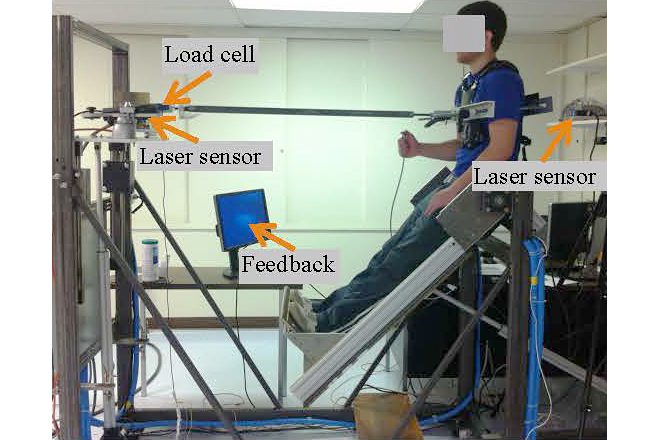Aging, Neuromuscular Behavior, and Risk of Occupational Low Back Pain
Perturbation devices used in the study

Goals & Objectives
Low back disorders, and particularly low back pain (LBP), remain as the most common and debilitating work-related musculoskeletal disorder. An increasing LBP prevalence with aging, along with an increasing participation of older individuals at work, motivates a better understanding of underlying mechanisms linking aging with LBP. This project seeks to investigate and identify the relationships between a risk factor (e.g., aging) and associated occupational injuries.
LBP can result from abnormal mechanics of the spinal column (i.e., higher spinal loads and lower stability) under diverse work activities and events. Spine biomechanics depend on the physical demands of a task/event (e.g., external loading), passive trunk mechanical characteristics (e.g., stiffness, and damping), and active mechanical neuromuscular responses to equilibrium and stability requirements. Despite current knowledge on the age-related degradations of trunk tissues, it is unknown how such changes can affect trunk mechanical behaviors (TMB) or how changes in TMB with age can influence spine biomechanics under various work activities/events.
Potential adverse effects on spine biomechanics include increases in spinal loads and decreases in spine stability for a given task/event (e.g., lifting/slip). Changes in TMB that could adversely affect spine biomechanics may include a stiffer trunk, reduced damping, increased reflex latencies, and decreased reflex responses. The goal of this project is to explore such relationships between aging and spine biomechanics by addressing two specific aims:
Aim 1: How does TMB change with age?
Aim 2: Do such age-related changes in TMB adversely affect spine biomechanics?
Project Approach & Activities
TMB and spine biomechanics will be evaluated using a set of in vivo experimental methods. The emphasis here is on aspects of existing biomechanical theory that link a risk factor (i.e., aging) to abnormal spine mechanics, specifically via the influences of the risk factor on TMB and spine mechanics, and which have not yet been explored. A relatively new set of experimental and modeling tools to assess TMB and spine biomechanics will be used to explore these aspects of the causal biomechanical theory.
A better understanding of potential causal mechanisms can not only contribute to prevention, but may also contribute to more efficient rehabilitation and safer return-to-work of workers with occupational LBP. By quantifying age-related alterations in TMB and the resultant effects on spine biomechanics, we expect to establish a foundation from which to develop and implement age-appropriate controls for LBP.
Faculty and Facility
PI: Barak Bazrgari (University of Kentucky); Co-Is: Maury Nussbaum (Virginia Tech), Deborah Reed (University of Kentucky), William Elder (University of Kentucky), Richard Kryscio (University of Kentucky).
Human Musculoskeletal Biomechanics Lab (HMBL) in Department of Biomedical Engineering at University of Kentucky
Student Researchers
Milad Vazirian, Rebecca Tromp, Brian Koch, Emily Croft (University of Kentucky)
Funding Source
“Aging, Neuromuscular Behavior, and Risk of Occupational Low Back Pain”, NIOSH (07/01/12 – 06/30/15), PI: B. Bazrgari (University of Kentucky), Co-Is: M. A. Nussbaum (Virginia Tech), D. B. Reed (University of Kentucky), W. G. Elder (University of Kentucky).
Sector: Cross Sector
Discipline: Musculoskeletal Disorders
PI: Babak Bazrgari (University of Kentucky)
Co-Is: Maury A. Nussbaum (Virginia Tech), Deborah Reed (University of Kentucky), William Elder (University of Kentucky), Richard Kryscio (University of Kentucky)


